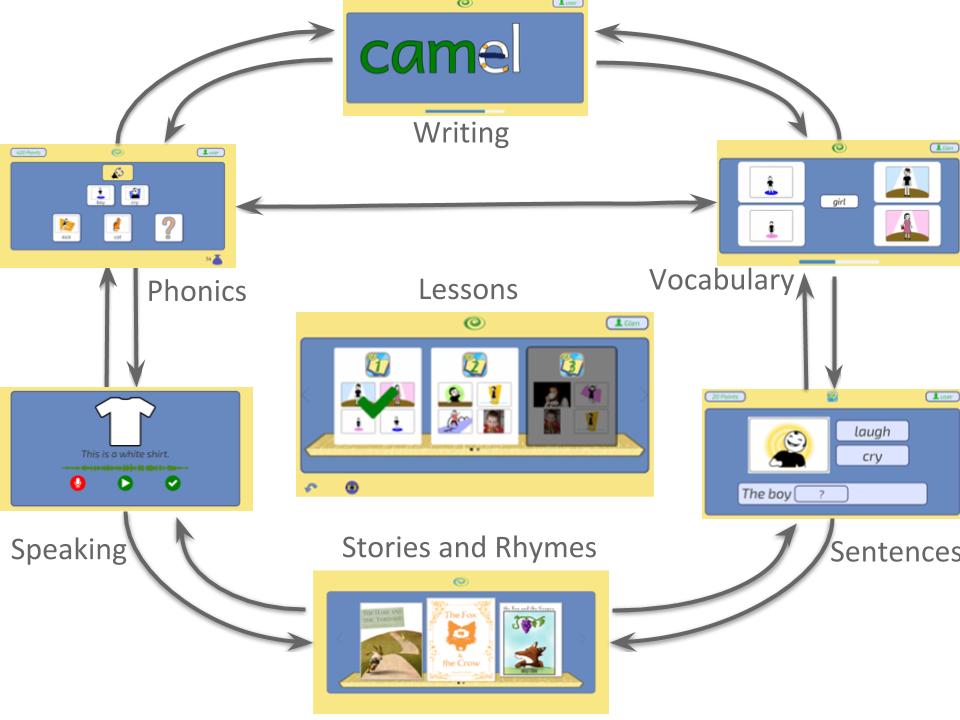Our flagship app, GLEN Learn, is structured as a set of lessons aimed at guiding a child from “zero to reading,” with heavy use of imagery and audio to create an immersive environment for literacy. The first step in this process is vocabulary acquisition. Once a child knows about 90% of the words in a typical piece of text she comes across, she can start inferring the meaning of the remaining 10%, and start making the transition from “learning to read” to “reading to learn.”
What does “knowing” a word mean? It starts with being able to associate audio and imagery for common words, and this is what our initial exercises focus on. The text for the word is also provided, but association of sound/image with text is meant to subliminal to start with.

Which words first? We focus on common nouns and verbs likely to be of interest to a child, such as other people, activities, and animals: “boy”, “girl”, “man”, “woman”, “run”, “jump”, “cat”, “dog”, “horse”, and so on. Also an elementary exposure to adjectives through colors: “red”, “blue”,…

We also start introducing the concept of describing simple scenarios by putting nouns and verbs together to form sentences: “The girl is eating.” Same goes with nouns and adjectives, but we start with just describing colors: “This is a blue car.”

Once there is some exposure to words through imagery and audio, we also start introducing sight reading of some of these common words.

And some tracing, to expose kids to the idea that if you write out a word, it actually means something: once you finish tracing a word, the image and audio appears.

We then start exposing children to phonics, starting with consonants at the beginning of words. From the very beginning, we expose kids to the idea that different letters or letter combinations may correspond to the same sound.

How do we know it’s working? Through built-in assessment: completion of a set of 5 lessons automatically triggers an assessment. The next set of 5 lessons becomes available when the assessment score exceeds a threshold. If it does not, this triggers a strengthening module. The assessment and strengthening cycle will loop until the assessment threshold is exceeded. Of course, a child can also go back and redo an earlier lesson at any time.
To summarize, in the first set of 40 lessons that we have released, our main focus is on vocabulary building, although we do provide a limited exposure to phonics and letter formation. Notice that we are not teaching the alphabet yet. English is not a phonetic language, and teaching the alphabet too early only leads to confusion: the concept that a letter can be named in a manner quite different from the sound it corresponds to is one that we will only get to once we are further along in phonics.
For our next set of lessons, rather than dictating a single flow, we will start giving choices. There are lessons on vocabulary building, lessons on phonics, and lessons on writing. Our target is for children to have a fairly strong grasp of a core vocabulary of around 200 words, with a mix of sight reading and phonics-based decoding. This will allow them to start decoding simple sentences, which will lead to the ability to read “very short stories.” The latter will mainly focus on everyday situations which might be encountered by a child, but with a touch of humor and whimsy. While we have automated to a great extent the generation of many of our existing lessons, the creation of these “very short stories” is going to require significantly more effort, since it requires the involvement of the creative writers and artists in our network. Put another way, this is where your donations will go!
Our immediate goal is to get pilot feedback on our first set of 40 lessons, focusing on before/after tests on vocabulary acquisition to judge their efficacy. Watch this space…we will report back on what we learn.

